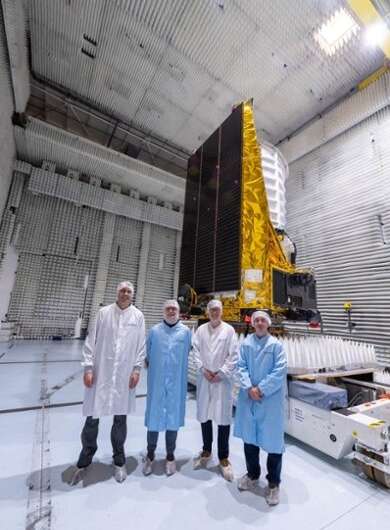After the launch of Euclid: ‘This is a big step toward understanding dark matter and dark energy’

What is it like to work on the fundamental questions about the universe? On July 1, the Euclid satellite launched successfully. This mission from the European Space Agency will take images of the sky to create the most detailed map of the universe ever made. Astronomer Henk Hoekstra (Leiden Observatory) and physicist Alessandra Silvestri (Leiden Institute of Physics) tell about their role in the mission.
The new space satellite is like the Google of the universe. “Euclid is basically a data-gathering machine,” Hoekstra explains. “What Hubble covered in 30 years, Euclid can do in one week in both optical and infrared wavelengths. So it’s a huge volume of data. With this, you are guaranteed to find the needle in a haystack.”
Hoekstra has multiple roles in the mission. He is the lead of the weak lensing group and one of the four cosmology coordinators. This means he was involved from the early stages to set the requirements for the accuracy of the data Euclid will obtain.
Silvestri on the other hand leads the theoretical physics group of about 200 people. They will analyze the vast dataset Euclid provides, hoping to discover new physics. “I have a helicopter view to make sure all the work comes together. It’s the first time I’ve been a part of a mission like this, so it is very exciting.”
Unprecedented data abundance and accuracy
Euclid is now on its way to its final destination in space but the road to get there was not without hurdles, according to Hoekstra. “The mission was not doing well in 2011, and there was a risk that it might be postponed or even canceled. We had to show that we could actually deliver the scientific goals. We had six months to turn the ship around and get the requirements right, and we managed. What makes it unique is that Euclid was designed to get not only a lot of data but very accurate data.” Silvestri says.
“This is exactly what we need for cosmology. Although it also poses a challenge for us theorists. Previously, some approximations in our calculations might have been acceptable, but not anymore with this level of accuracy.”

Understanding dark energy and dark matter
Silvestri cannot wait until the images from Euclid will start coming in. “The colossal scale of this survey allows us to really take big steps forward. We have this strange universe and there are plenty of ideas about how it works, but none of the candidate cosmological models are entirely satisfactory or correct. This is the first time we will have access to this kind and amount of data allowing us to test the theory and study these big questions. What is the nature of dark matter and dark energy? Does gravity work differently on these large scales?”
Hoekstra says, “It’s the first big step forward to guide the way for understanding dark energy. Of course, we will also learn a lot about galaxies, galaxy formation and other interesting things, but dark energy and dark matter really drive this mission.”
Studying the invisible universe
Euclid will create a 3D map of a third of the sky, allowing scientists to study the last 10 billion years of the universe’s evolution. The main goal is to explore the nature of dark matter and dark energy. More is unknown than known about these concepts.
Everything on Earth and everything ever observed with all telescopes and satellites—all normal matter in other words—adds up to less than 5% of the universe. The rest is made up of the mysterious dark energy and dark matter but neither can be observed directly. Researchers know they exist through their effects on the universe.
Waiting for the first images
Both researchers agree that physics and astronomy come together beautifully in the Euclid mission. “We look at the same science questions,” Hoekstra says. Silvestri adds, “And that brings us together. Astronomers work hard on characterizing the galaxies and measuring their shapes with great accuracy. That in turn can help physicists to infer new physics. We really complement and need each other in that sense.”
Hoekstra was present on the launch site in the U.S. “At launch, you realize that it is a fragile instrument. So many things can go wrong. I’m relieved it went smoothly after fifteen years of preparations.”
On the day of the liftoff, Silvestri was at the main mission control center in Germany, where a dedicated ESA team took over control of the telescope soon after launch. “The excitement was palpable, as was the huge relief when we received the first signal from Euclid. Now we have to wait a few months for the first data to start coming in,” she says. “The best is yet to come.”
Citation:
After the launch of Euclid: ‘This is a big step toward understanding dark matter and dark energy’ (2023, July 7)
retrieved 7 July 2023
from https://phys.org/news/2023-07-euclid-big-dark-energy.html
This document is subject to copyright. Apart from any fair dealing for the purpose of private study or research, no
part may be reproduced without the written permission. The content is provided for information purposes only.
For all the latest Science News Click Here
For the latest news and updates, follow us on Google News.

